Here's the text.
Soil Contamination Countermeasures System
Last Updated August 20, 2024
Introduction
The City of Yokohama provides regulatory guidance on soil contamination measures based on the Soil Contamination Countermeasures Act (hereinafter referred to as the "Law") and the conservation City Living Environment Ordinance (hereinafter referred to as the "Ordinance").
The law prevents human health damage caused by soil contamination, and the ordinance finds soil contamination (investigation triggers and surveys) for the purpose of conservation living environment, informs the public (designation of areas and public announcement in the Yokohama City Newsletter), and implements measures to remove pollution and manages land that may cause health damage (advance notification at the time of character change and unloading, etc.).
(Excerpt from the Ministry of the Environment, Japan Environment Association, "Mechanism of Soil Contamination Countermeasures Law")
In laws and ordinances, the standard values for the regulation of specific hazardous substances are the same, but the ordinance has a wider scope of regulation, and those that do not fall under the law may be subject to regulation in the ordinance.
Please refer to this page for procedures related to soil contamination.
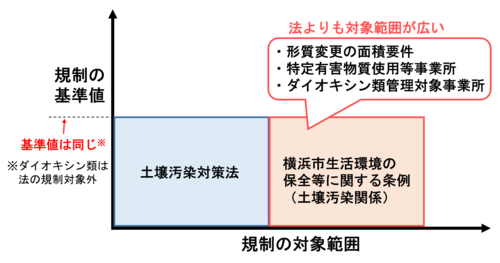
About soil contamination
Soil contamination refers to a condition in which soil is contaminated by substances that are harmful to humans. The cause may be the improper handling of harmful substances used as raw materials in connection with the operation of the factory, or liquids containing harmful substances may be immersed underground. In addition, soil contamination includes not only contamination caused by human activities, but also those that are naturally contaminated. (Excerpt from the Ministry of the Environment, Japan Environment Association, "Mechanism of Soil Contamination Countermeasures Law")
Based on laws and regulations, Yokohama City provides regulatory guidance on soil contamination caused by 26 types of specified hazardous substances and dioxins.
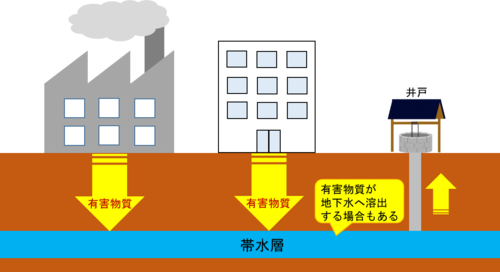
Health risks from soil contamination
The laws and ordinances consider the health risks caused by soil contamination in the following two cases, and to manage these health risks, standard values are set for each specific hazardous substance.
①Risk of intake via groundwater, etc.
This is the risk of toxic substances contained in soil dissolving into groundwater and eating groundwater containing the harmful substances. Soil elution standards have been set for each specific hazardous substance.
(Example) When there is a well or faucet to drink groundwater around the land where soil contamination is present.
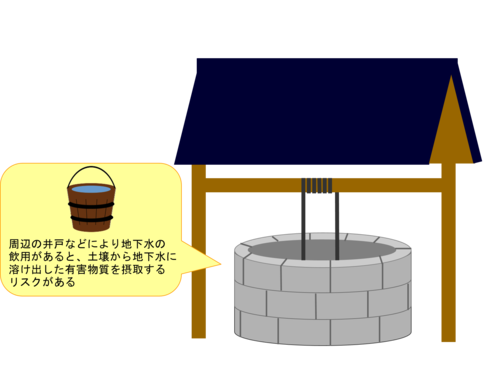
②Direct intake risk
This is the risk of taking harmful substances contained in soil directly from the mouth and skin. Soil content standards have been set for each specific hazardous substance.
(Example) When a child eats the soil on his hand while playing in the sandbox, or when the soil scattered by the wind enters the mouth directly.
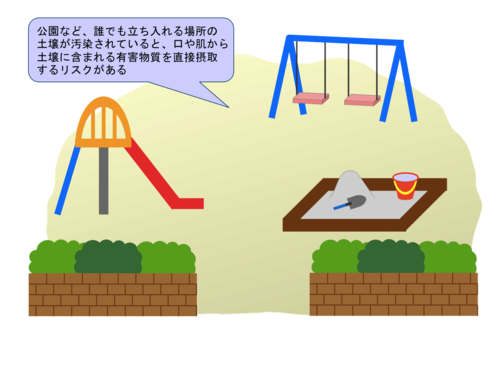
(Excerpt from the Ministry of the Environment, Japan Environment Association, "Mechanism of Soil Contamination Countermeasures Law")
Research opportunity
In order to understand a wide range of soil contamination, laws and ordinances set the following opportunities for soil surveys.
| Items | Soil Contamination Countermeasures Law (Article 3) | Ordinance on conservation, etc. of Yokohama City Living Environment (Article 64-2) | Ordinance on conservation, etc. of Yokohama City Living Environment (Article 70-2) |
|---|---|---|---|
| Opportunities for Investigation | When "facility" or "use of harmful substances, etc." is abolished in "specified facilities using harmful substances" specified by the Water Pollution Control Law and the Sewerage Law | When the “business establishment such as the use of specified hazardous substances” specified in the ordinance is abolished (excluding the subject of the Soil Contamination Countermeasures Law) | When "business establishments subject to dioxin management" specified in the regulations are abolished |
| Substances to be surveyed | Specific hazardous substances (26 substances) | Specific hazardous substances (26 substances) | Dioxins |
| Person who is obliged to report | Owner, manager or occupant of land | Owner, manager or occupant of land | Establishment of Offices |
| Investigators | Designated survey organization (outside site) | Designated survey organization (outside site) | Person who can investigate appropriately |
| Postponement of investigation | Yes | Yes | No provision |
| Conditions for deferral of investigation | Continue to be used as a factory site, etc. | Continue to be used as a site of a business establishment (only when a building is used) | None |
| Items | Soil Contamination Countermeasures Law | Soil Contamination Countermeasures Law (Article 4) | Ordinance on conservation, etc. of Yokohama City Living Environment (Article 65) | Ordinance on conservation, etc. of Yokohama City Living Environment (Article 70-3) |
|---|---|---|---|---|
| Notification requirements | Change of character of land more than 900 square meters in "land pertaining to confirmation of proviso of Article 3 of the Act" |
|
| Changes in land characteristics (no area requirement) at “Dioxin Management Business Sites” |
| Notification exclusion requirements |
|
|
|
|
| Person who is obliged to report character change | Owner, manager or occupant of land | A person who intends to change the character of the land | A person who intends to change the character of the land | A person who intends to change the character of the land |
| Opportunities for Investigation | When we receive investigation order from the mayor after report | After notification, when a survey order is received as there is a risk of soil contamination on the land subject to the change of characteristics (it is also possible to report the results of the soil survey together with the notification). | After notification, when a survey order is received as there is a risk of soil contamination on the land subject to the change of characteristics (it is also possible to report the results of the soil survey together with the notification). | When it does not meet the following requirements for requiring a survey report |
| Substances to be surveyed | Of the specified hazardous substances (26 substances), specified hazardous substances with a history of use, etc. in the area | Of the specified hazardous substances (26 substances), specified hazardous substances ordered by the mayor as there is a risk of soil contamination | Of the specified hazardous substances (26 substances), specified hazardous substances ordered by the mayor as there is a risk of soil contamination | Dioxins |
| Person who is obliged to report | Owner, manager or occupant of land | Owner, manager or occupant of land | Owner, manager or occupant of land | A person who intends to change the character of the land |
| Investigators | Designated survey organization (outside site) | Designated survey organization (outside site) | Designated survey organization (outside site) | Person who can investigate appropriately |
When the The Mayor of Yokohama ordered an investigation to conduct a health hazard.
Land with high probability of soil contamination, and if there is contamination, land that may be consumed by humans may cause damage to human health.
Since such land needs to investigate the situation of soil contamination and take necessary measures, prefectural governors (The Mayor of Yokohama in the case of land in Yokohama City) can order the land owners to conduct surveys and report the results. (Article 5, Paragraph 1 of the Act)
Investigation orders are not subject to land where measures such as the removal of pollution have been taken (including during the implementation of measures), mines in operation, and the site of their affiliated facilities.
(Regulations) Soil Contamination Survey
If you are ordered to investigate the status of soil contamination, ask a designated research organization to investigate. For land for which an investigation is required, a ground history survey will be conducted first to classify the risk of contamination. As a result of the ground history survey, if it corresponds to (1) land that is deemed to have little risk of soil contamination, or (2) land where there is relatively high risk of soil contamination, a soil gas survey or soil collection survey is required. It becomes.
In addition, as a result of the soil collection survey, if the specified hazardous substance exceeds the soil elution standard, it is necessary to conduct and report a groundwater survey based on Article 68-2 of the Ordinance.
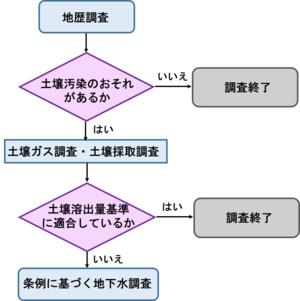
Flow of Survey
Designation of Area
(Regulations) As a result of the soil contamination status survey, land where the soil contamination status does not conform to the designated standards will be designated as (regulations) required action areas or (regulations) required notification areas at the time of character change based on laws or ordinances.
If there is a drinking well in the surrounding area and there is a risk of health damage due to soil contamination, it is designated as a (regulation) requiring action, and if there is no risk of health damage, it is designated as a notification area required at the time of character change , Land ledger is published.
(Regulations) In areas requiring action, changes in land characteristics are prohibited in principle until measures are completed. (Ordinance) About report area required at the time of trait change, report is necessary within 14 days before change of trait of land.
Cancellation of designation of area
The requirement for the cancellation of the designation of the designated area is when the soil contamination removal measures (excavation removal measures or original location purification measures) is completed and it is confirmed that there is no soil contamination on the land. In addition, if groundwater contamination occurs, it will be done after confirming that no groundwater contamination will continue for two years. About land where designation of area was canceled, we announce ledger.
In addition, when measures other than removal (enclosure of the original position, insolubilization of the original position, embankment, pavement, etc.) are taken, there is no change in the soil that exceeds a certain standard Therefore, the designation of the area is not canceled.
Other Systems
| Items | Soil Contamination Countermeasures Law | Ordinance on conservation, etc. of Yokohama City Living Environment (Specific Hazardous Substances) | Ordinance on conservation, etc. of Yokohama City Living Environment (Dioxins) |
|---|---|---|---|
| Publication of survey results information | 「Areas requiring action」 「Notification area required at the time of character change」 Published the ledger | 「Areas required by ordinance」 「Notification area required at the time of ordinance character change」 「Ordinance conforming land」 Published the ledger | 「Dioxin soil contamination report ledger」 And announced |
| Designated application | You can apply for area designation voluntarily (Article 14 of the Act) | No provision | No provision |
| Preservation and succession of records of use of specified hazardous substances, etc. | No provision | A person who has established a business establishment, such as the use of specified hazardous substances, records and saves the results of a survey on the use of specified hazardous substances at least once a year. If the business operator and the landowner are different, the record shall be sent to the landowner at least once a year. (Article 64 of the Ordinance) | A person who has set up a business site subject to dioxin management records and saves the results of a survey on the use of the facility at least once a year. If the business operator and the landowner are different, the record shall be sent to the landowner at least once a year. (Article 70 of the Ordinance) |
| Investigation report on the impact of soil contamination on groundwater | Investigations and reports are required based on ordinances when they do not conform to the elution standards (Article 68-2 of the Ordinance). | Investigations and reports are required when they do not conform to the elution standards (Article 68-2 of the Ordinance) | Investigations and reports are required when they do not conform to the standards (Article 70-5 of the Ordinance) |
Inquiries to this page
Water and Soil Environment Division, Environmental Conservation Department, Yokohama City Green Environment Bureau
Telephone: 045-671-2494
Telephone: 045-671-2494
Fax: 045-671-2809
Email address: mk-dojo@city.yokohama.lg.jp
Page ID: 775-518-322







